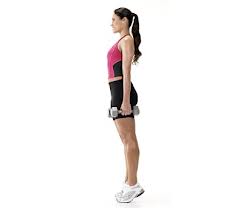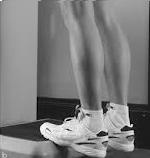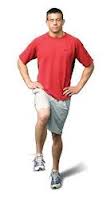I recently had a request for a blog that dealt with feet. Unstable ankles mostly, which is actually pretty common.
I think the best place to start is with the muscles. There are some muscles in the foot that originate and insert only in the foot. But mostly there are tendons from muscles that originate in the lower leg that insert in the foot. The best way to “strengthen” the foot is to strengthen the muscles in the lower leg.
Basic calf raises are the easiest to execute and are great for increasing functional strength in the lower leg. Every time you take a step you execute a calf raise. With your legs straight you are targeting your gastroc muscle (the powerful, more visible calf muscle). You can also do this seated which would target your soleus (the endurance of the calf muscles). Of course, while standing you are using your body weight (you can hold weights also); while seated, you need to put a weight or plate on your quads to provide resistance.
For further challenge, stand on a step with your feet over the edge so that you can drop your heels below the step and come up from a negative position. This can be done when you are able to accomplish the above exercises without difficulty. The muscle fibers here begin on stretch then contract to optimal length, then to a contracted position; therefore, causing more muscle work and fatigue.
Once these exercises are simple enough, you can simply do them on 1 foot.
When ankles are unstable, it generally means the ligaments are having a difficult time keeping your position against gravity. The stork stance is another simple exercise in theory but many people with ankle injuries have difficulty keeping their balance. Stand on one leg, and hold for about 15-20 seconds at the beginning. If you feel that you are losing your balance, it’s better to touch down with your other foot than to wobble around trying to regain your position. To make it more difficult, you can close your eyes (harder than it sounds!). Past that, you can stand on an unstable surface such as a bosu ball, fit disc, or pillow (keep your eyes open). Another great way to work your proprioception, is to toss a ball to a wall while in your stork stance. Mix it up a little and toss to the wall in a different spot each time so that you need to adjust for the dynamic nature of the ball coming back at you. Again, when losing your balance, touch down with the other foot instead of wobbling around.
These are simple exercises that you can try at home. If you are having difficulty with the range of motion of your ankles or experience sharp pain with any of the above movements, you need an assessment. Having strong/stable ankles helps with more activities of daily living than you might think. Having a strong base will improve movement patterns in your knees, hips, and lower back.
Let me know what you think! If you want to request more exercises or have questions about other injuries, please leave a comment.
Jen Mark BSc., CAT(C), CSCS
Athletic Therapist
www.dynamicliving.me
www.facebook.com/dynamiclivingtoronto


